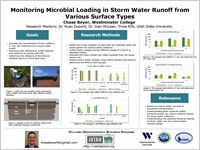iUTAH Team - Undergraduate iFellows
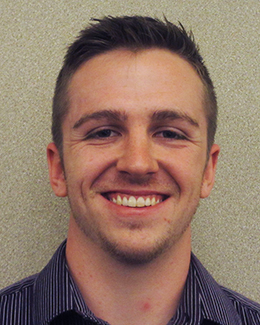
Chase Beyer
Westminster College
Mentors:
Faculty: Ryan Dupont, USU
Faculty: Joan McLean, USU
Near-Peer: Trixie Rife, USU
Research Focus:
Research Focus Area 2
Project: Monitoring Pollutant Loading and Removal Efficiency through Shallow Dry Wells Used for Stormwater Capture
Major:
Biology
Biography:
Chase Beyer is a senior at Westminster College where he studies biology and applied mathematics. He enjoys the study of ecology and microbiology especially. In his spare time, he loves to tinker with vehicles and technology, and go backpacking, and camping. Chase hopes to one day help develop green energy technology as a career. He is super excited to help examine the microbiology of storm water and the effectiveness of storm water recovery systems.
Research Abstract:
The introduction of pollutants into storm water runoff can be rather concerning since it can be collected for personal use, infiltrate groundwater systems, or find its way into irrigation canals. This means that storm water can act as a vector for environmental pollution or even household contamination. Environmental factors such as roofing materials, ground surface type, or vegetation can affect the extent of runoff pollution. This study will assess the microbial contamination of storm water runoff from various sources including a metal roof, an irrigation canal, and dry collection wells in a parking lot and a planter box on the USU campus. The microbes being tested for are coliforms and E. coli, as they are indicators for fecal contamination and possible presence of other harmful microbes. ISCO auto samplers were used to gather storm water samples from dry collection wells and surface gutters located across the Utah State University campus. Collection sites included the parking lot of the Education building, a water sump adjacent to the Engineering building that collected water from the roof, and a planter box adjacent to the Distance Education building. Additional grab samples were collected from gutters attached to a pump house roof, one to collect from the metal roof and another to collect from a photovoltaic cell. Grab samples were also taken from the Hyde Park canal. The concentration of coliforms and E. coli in the samples was determined using the IDEXX Quanti-tray 2000/Coliert system.
Weekly Recap:
Week 1 | Week 2 | Week 3 | Week 4 | Week 5 | Week 6 | Week 7 | Week 8 | Week 9 | Week 10 | Week 11
Week 1: May 15-21, 2017
Earlier this week, I got a quick tour of the Utah Water Research Laboratory 3rd floor lab and attended meetings with the rest of the storm water crew. We then went around the USU campus and checked out the collection wells and how they’re sampled. Thursday, we went down to Salt Lake to check out the auto-sampler there and collect samples. The sampler is super cool! I have been filtering samples and getting them prepped for metals analysis lately, which can be interesting but sometimes leads to long periods of waiting. I must order some IDEXX trays for microbe analysis and get access to the biology lab equipment, which should be doable next week. Until then, there are samples to process!
Earlier this week, I got a quick tour of the Utah Water Research Laboratory 3rd floor lab and attended meetings with the rest of the storm water crew. We then went around the USU campus and checked out the collection wells and how they’re sampled. Thursday, we went down to Salt Lake to check out the auto-sampler there and collect samples. The sampler is super cool! I have been filtering samples and getting them prepped for metals analysis lately, which can be interesting but sometimes leads to long periods of waiting. I must order some IDEXX trays for microbe analysis and get access to the biology lab equipment, which should be doable next week. Until then, there are samples to process!
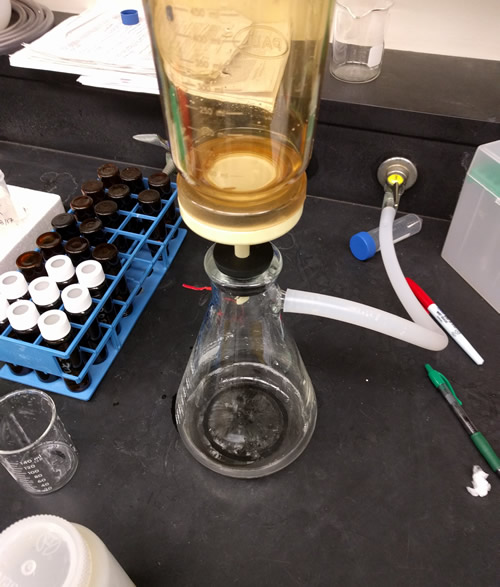
Filtering the sediment from stormwater using vacuum filtration
Week 2: May 22-28, 2017
The past week has been fairly interesting. I have spent minimal time in the lab; which primarily consisted of more lab specific training. Lately, we have been working on developing the bio-retention bays in the Green Meadows housing development. This mainly consisted of hauling wheelbarrows of dirt into the bays, followed by compost. We have also developed a method to insert and remove a pH probe into the ground to monitor pH levels over time. I have also priced out and ordered the IDEXX equipment I will need for microbial analysis so next week I will be able to start collecting samples and testing them. We have already developed a method for collection and I have access to the biology building to use their IDEXX sealer. Dr. Dupont and I have also talked to Dr. Weidhaas at the University of Utah to perform species of origin analysis for the microbes we find in the samples. She will be visiting next week to show us the method after we collect from the wastewater treatment plant on Thursday.
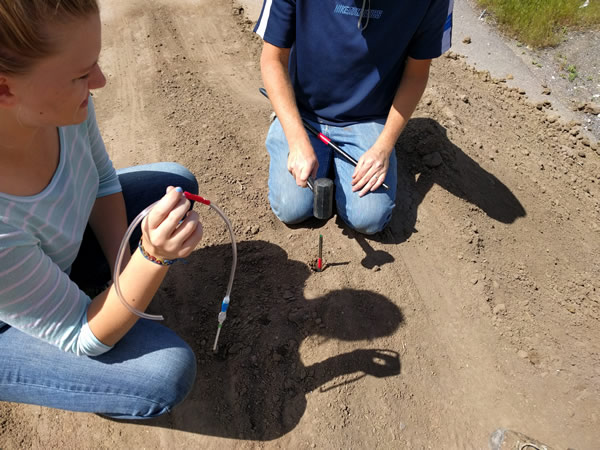
Working with fellow undergrads Eliza and Connor to make a hole for the pH probe via a tamping method using two different sizes of steel rod.
Week 3: May 29-June 2, 2017
This was a short week, but there was a ton going on. Tuesday was spent developing the Green Meadows site again, where we made a ton of progress. Wednesday was pretty interesting since I got to help out on installing sampling hardware in a river in Brigham City, where I was able to wade in the river on a sunny day. Dr. Weidhaas from the U came to show us how to process samples to extract cells from the water so she can do further analysis to determine species of origin. The IDEXX equipment also came in and we were able to run samples from wastewater treatment plants and from irrigation canals in Logan.
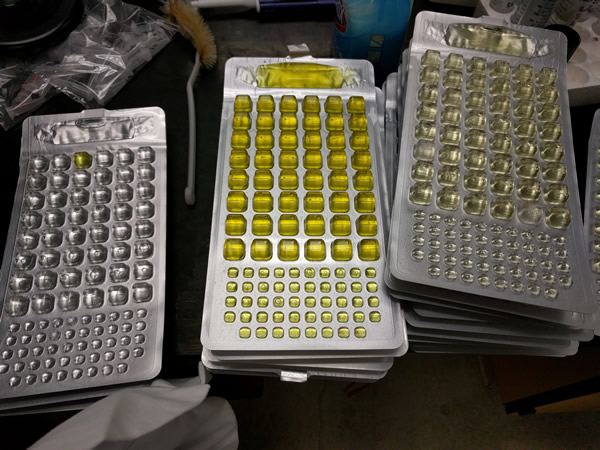
Some IDEXX trays after 24 hours of incubation. These include tests for E. coli, coliforms, and enterococci.
Week 4: June 5-9, 2017
Ohhh boy… this was a good week. Green Meadows is now done, mulch and all. Trixie, Connor, and I went down to Salt Lake to pick up a couple auto-samplers to use in my project Thursday, and promptly bleached and cleaned them. Now, I pretty much have a flee of auto-samplers on use on my project that are all ready to go. We have also set up two sampling sites on the USU campus; there is a third site, but we ran out of tubing for the samplers. We have also been running more tests on the canal water to dilute it enough so that our tests are not totally overloaded, those will be ready to read later tonight. There might be some rain next week, so let’s hope for the best!
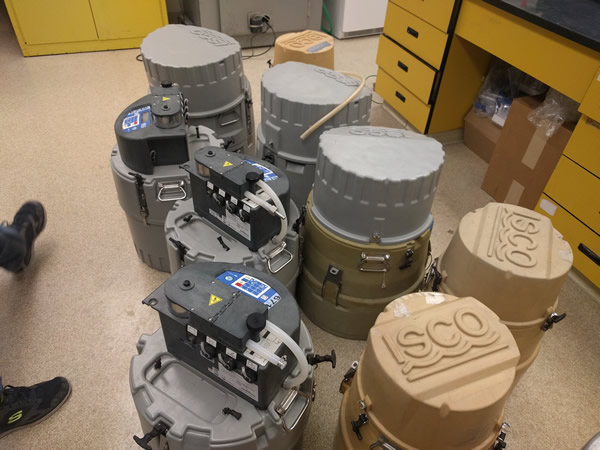
The fleet of auto-samplers to be used for sampling water from collection wells. Each site will have two auto-samplers since there are two wells.
Week 5: June 12-16, 2017
I hit the ground running this week with the rain we had Monday and Tuesday. Monday was not too bad since only our collection gutter was filled with stormwater, as there was not enough for groundwater penetration. However, by Tuesday morning there was plenty of samples to collect. First off, we collected samples that were taken during the night and were tool old for microbial analysis and distributed them to Trixie for metals and nutrient analysis. Then we took additional grab samples from the collection wells, along with more samples from the collection gutter, and samples from roofs that morning for microbial analysis. Yes, it was pouring and freezing at the time. More samples were taken in the afternoon from the same sources. All of the samples were processed for analysis that afternoon and we read the results Wednesday. The rest of the week was spent gathering more level actuators to alleviate the need to take grab samples and double checking the other samplers to be deployed to more sites on campus.
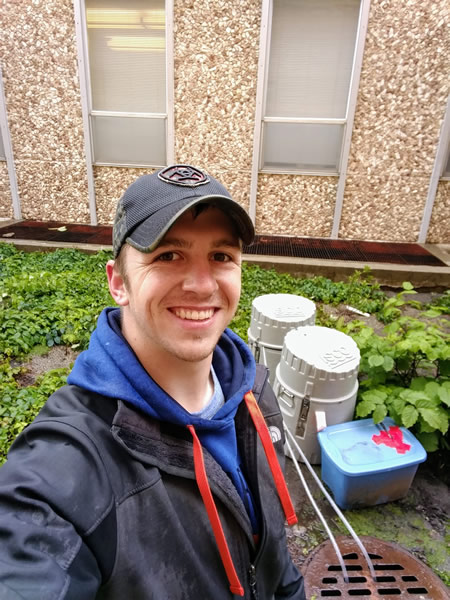
Myself with the two autosamplers that are responsible for pulling water from collection wells at the bottom of the sump pictured.
Week 6: June 19-23, 2017
Monday was interesting with some field trips examining the Logan River and current restoration efforts, along with some data quality control exercises. Most of the week was pretty slow since there was no rain and we are still waiting on things to come in the mail. I did however do training to drive USU vehicles and use the P-card, so I was able to go to Home Depot and pick up supplies and put up a second gutter on Pump House 1 and a rain gauge near the Engineering building. We also finally got our second delivery of IDEXX supplies and we found where the tubing for the auto samplers was sent. Briefly, the office looked like it may become a box fort. We organized the IDEXX supplies and used he new tubing to calibrate samplers that have yet to be deployed. Friday evening was spent doing much needed maintenance on the Education collection wells, which involved filling in eroded ground around the wells and replacing a defunct sampler.
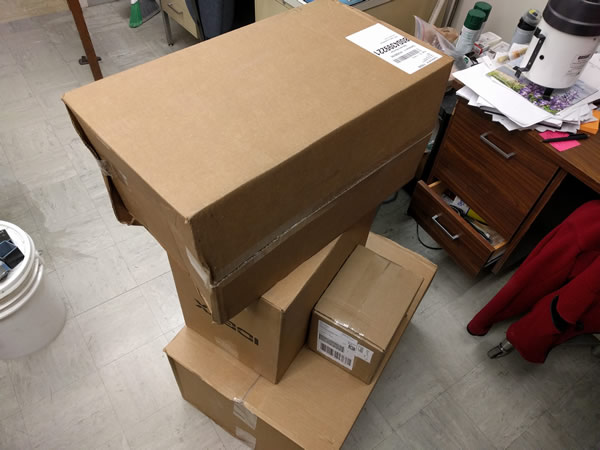
The pile of new IDEXX supplies, which stood about 4 feet tall.
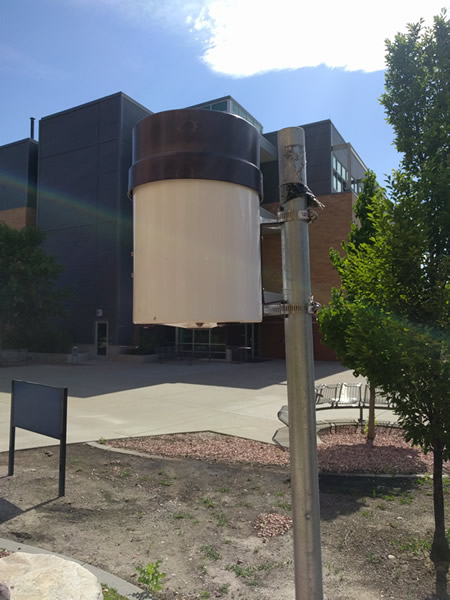
The rain gauge that is installed in front of the Engineering building that will capture rainfall rates if there were to be more rain.
Week 7: June 26-30, 2017
Not a whole lot went on this week that directly relates to my project. What we did do was put a tipping bucket in the bottom of the sump at the Engineering collection site, so we can have an auto sampler sample roof drainage directly. We also replaced a couple dead batteries and collected minor samples from the pump house roof and the 6-foot well at Engineering. The Green Meadows site also got some much needed weeding in the bays and some sunflower plants were transplanted in, since the sprout rate of the seeds was not so great. Thursday evening I also went to Bear Lake to grab some shakes with some other iFellows, Jared, Emily, and Chris. We planned on playing spike ball, but couldn't really find a spot to play and it got cold really quickly when the sun went down, so our visit was really brief. That's it for this week! Next week I have to simulate some rainfall for more data and wrap up my poster!

Bear Lake and the sign referencing the now underwater beach.
Week 8: July 3-7, 2017
Simulating rain events on a small patch of roof is not quite as easy as I thought it would be. To gather more detailed data for the pump house roof, I have been using a backpack sprayer to spray water onto a metal portion of the roof and the photovoltaic cell and collecting samples from each surface. This requires 7.14 gallons of water and two nearly full sprayers. Standing on a ladder in the middle of a day pumping a heavy sprayer strapped to your back is not fun at all. However, this simulation has answered some interesting questions I've had. For this week's cohort meeting, we gave our preliminary poster presentations. I was nervous for mine, but I received some very positive feedback. We also went to the Red Butte garden area to check out the dam there, which was AMAZING! The day was blazing hot, but being able to check out the dam up close and checking out the control room was really worth it.

Reservoir from top of dam
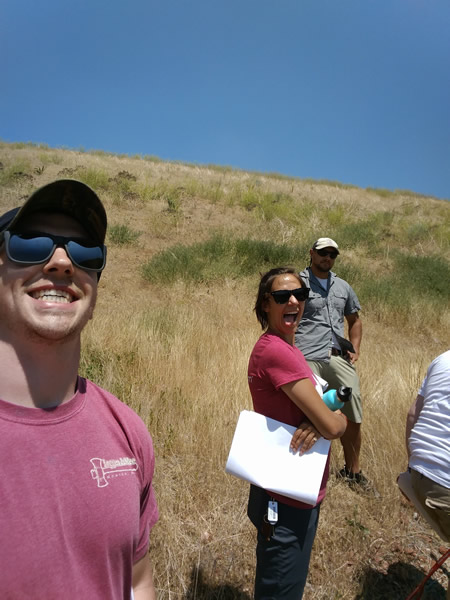
Being weird
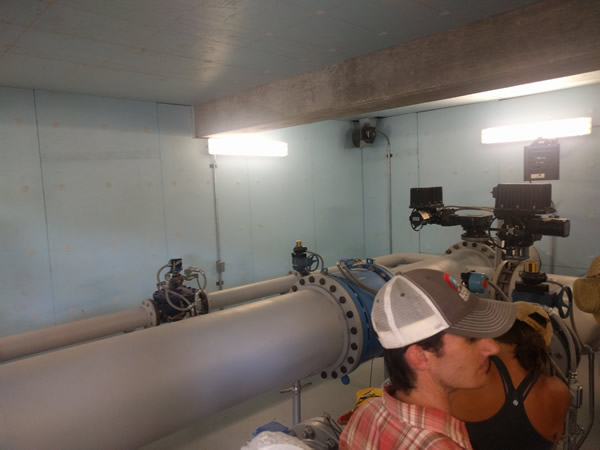
Dam control room
Week 9: July 10-14, 2017
This week was a rather interesting week. I managed to finish up my rain simulations and process the data. I did my final updates on my poster and printed it at 4:30 Wednesday (last minute, I know). Thursday was day one of the iUTAH symposium, which was quite amazing. The morning started off with some coffee and fruit, then the plenary sessions with headlining presentations about iUTAH and the progress made over the years. Near the end of this, myself and the rest of the iFellows were excused to eat lunch and set up posters. We also had a very wonderful photo shoot (hope to see those pictures soon). Shortly after, we began presenting. I was nervous at the initial sight of the flood of people, but I soon found a "groove" in my presentation and gained confidence as I went along. Later, we were able to go to the breakout session to see some of the research conducted under iUTAH. That night was a get-together at Andy's house, where it was really fun to hang out with other researchers and iUTAH folks outside of work. Friday was another great day! It was the second day of the all-hands iUTAH meeting, but it was less about research but about the people of iUTAH and its impact on research in the state of Utah and beyond. Here I realized how much of iUTAH was a group of brilliant colleagues and friends who are incredibly passionate for bringing scientific discovery to Utah. It was amazing to gain perspective on how small iUTAH was before and how massive it had become. Very deserving people received awards, some heartfelt speeches were given, and we ended it with a delicious lunch.
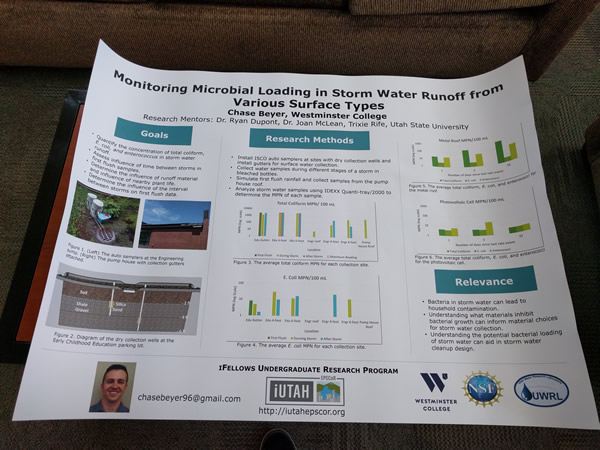
My final poster, freshly printed for the symposium.

Andy opening the second day of the iUTAH all-hands meeting.
Week 10: July 17-21, 2017
Week 11: July 24-28, 2017
The last week of iFellows was an exceptionally short one, but still eventful. I spend a vast majority of my weekend finishing up my extended abstract and presentation to make room for moving later in the week. Tuesday was the last day at the lab for me AND there was rain, so Conor and I spent half the day out and about collecting samples for Trixie. All and all, a nice final day at the UWRL. Wednesday was the iFellows symposium, which was amazing! It was great to see how all of us grew from the first orientation to this final presentation of our Summer's work.
It's been a fantastic experience being an iFellow. I really appreciate everyone involved in running such an amazing program. Thanks for letting me tag along!
All content provided on this iUTAH Team - Undergraduate iFellows weekly recap is unedited, updated by each participant to provide a review of their progress, and is for informational purposes only.

